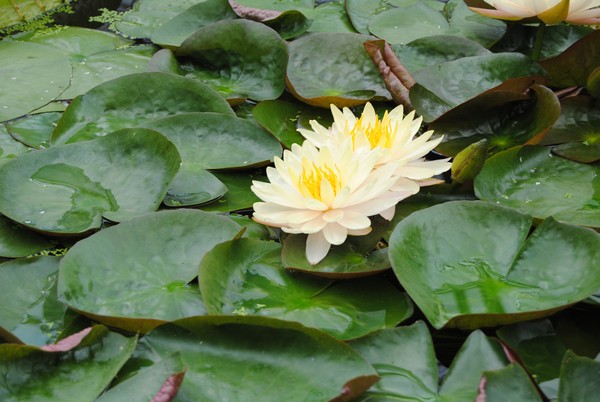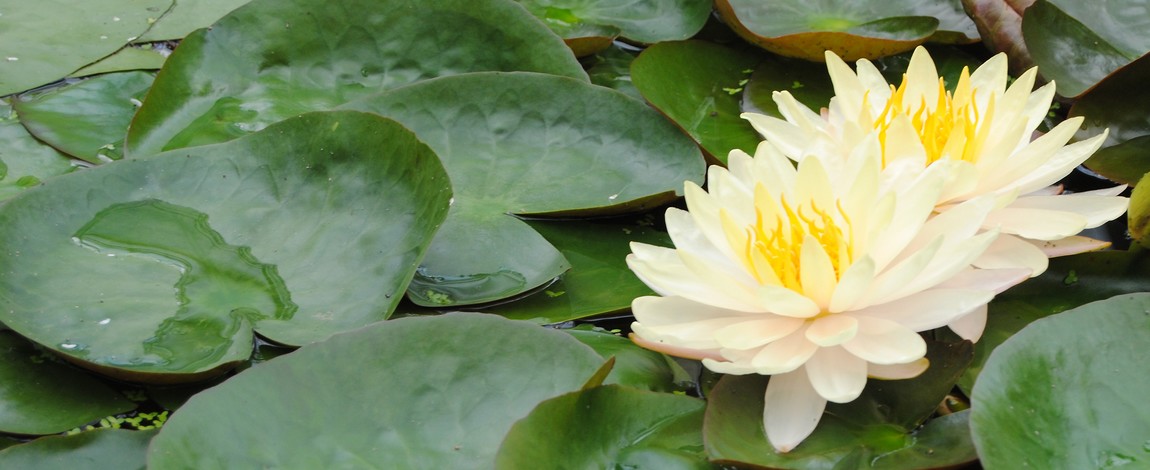
The difference between lotus and water lilies is not obvious. The general rule states that the leaves of water lilies may be partially submerged by the weight of the water that soaks them, while the water slips on the leaves of the lotus, and this allows them to stay above the surface of the water. It seems easy, but there are many different types, shapes, sizes, and circumstances that could make us wrong. So when in doubt, if we don't have anyone close to help, the best thing is to simply enjoy their beauty. There is something magical about contemplating a pond where the flowers seem to float, even though we know they are strongly rooted in the mud at the bottom.
According to the general rule, we see water lilies in the photograph at the beginning of the article. Water lilies as mentioned by Emanuel Geibel in his poem Die stille Wasserrose, the ninth of his second collection, the early work Lieder als Intermezzo, which was published in 1836. Geibel describes a scene at night in four stanzas. In each of the first three stanzas, he introduces, in third person, an element: the flower of the water lily, the moon, and the swan. He gradually introduces us to the scene; it appears that the sun has just set because the water is still blue and the moonlight is golden. The quiet and stillness of the first two stanzas are slightly altered by the swan, which moves around the flower and sings quietly. In the final stanza, the poetic voice asks the flower if she understands what the swan sings. The reference to the legend that swans only sing once in their lives, just before they die, is above the poem. And so ends the poem, with this enigmatic question. A truly romantic scene, all things considered.
Clara Schumann set this poem into music in 1842. She was preparing a publication, and she had assembled four Lieder she had composed recently—it seems that all of them were gifts she had made to Robert for his birthday and Christmas—and added two Lieder with poems by Geibel. The second, which would conclude Opus 13, was Die stille Wasserrose, but the composer changed the first verse, which became Die stille Lotosblume. That's why we have lotus and water lilies in the title of the article. I can't tell you why she did that. Maybe it was because the lotus was more exotic; I would say that water lilies are more common in Europe. Or perhaps to “pair” her Lied with Robert’s Die Lotosblume. It might be that it was simply why did she like lotus more than water lilies. I couldn't come up with an explanation.
With one flower or another, the song is one of those beautiful miniatures that deserves a few repeated auditions to capture all its subtleties. The first two stanzas are almost identical, and it seems that we are listening to a slightly varied strophic song. When the second stanza ends, there is a brief interlude that could make us think that something new is coming. However, it does not arrive immediately: the first two verses of the third stanza follow the same pattern as the first two, and it is not until the last two that the melody changes more appreciably. The fourth stanza, which begins by repeating the third verse of the third stanza, “Es singt so süss, so leise”, also starts with this new melody, it is not like the previous ones. Actually, the last two verses of the poem are separated from the rest by another brief interlude, which highlights the question with which the poem ends, which the composer repeats. I know this may seem complicated, but if you follow these lines the first time you hear the song, it will become clearer.
With or without a guide, I hope you enjoy Die stille Lotosblume, which we will hear in a wonderful version, that of Wolfgang Holzmair and Imogen Cooper.
Die stille Lotosblume
Steigt aus dem blauen See,
Die Blätter flimmern und blitzen,
Der Kelch ist weiß wie Schnee.
Da gießt der Mond vom Himmel
All seinen gold’nen Schein,
Gießt alle seine Strahlen
In ihren Schoß hinein.
Im Wasser um die Blume
Kreiset ein weißer Schwan,
Er singt so süß, so leise
Und schaut die Blume an.
Er singt so süß, so leise
Und will im Singen vergehn.
O Blume, weiße Blume,
Kannst du das Lied verstehn?
Please follow this link if you need an English translation
















